America Obscura (9)
By:
December 17, 2016
HILOBROW friend Andrew Hultkrans is a legendary freelance journalist; we have admired his range, erudition, and virtuosity since the early ’90s, when he was a columnist at MONDO 2000. We’re proud to publish this series of essays by Andrew, each of which originally appeared (as noted) elsewhere.
Divine Inc. – The Satanic Cosmology of Jack Chick
Did you know that Christmas is actually a Satanic holiday based on Baal worship from ancient Babylon? That Halloween is a Druidic ritual of human sacrifice… to Satan? That the Pope is the Antichrist?
If the answer is yes, chances are your sorry-ass soul has been saved by Jack Chick, comic book evangelist.
Although spewers of fire ‘n’ brimstone are not exactly rare nowadays, they tend to focus on small corners of a sprawling theological castle historically maintained by Lord Chick. His innovative method of spreading the Gospel through comics, his spiraling conspiracy theories, and his recurrent cast of characters make him a sort of Walt Disney of fundamentalism. Chick’s universe, like Disneyland in reverse, is one of hermetic paranoia — the tendrils of Satan’s influence on humanity reach from the highest seats of power to the most mundane suburban activities — describing a tightly knit web of evil design percolating just below the surface of everything. Chick’s brand of Christianity is anti-sectarian, “born again,” New Testament literalism. His mail-order congregation consists of what he calls “true Bible-believing Christians,” to whom he preaches DIY salvation and soul-winning.
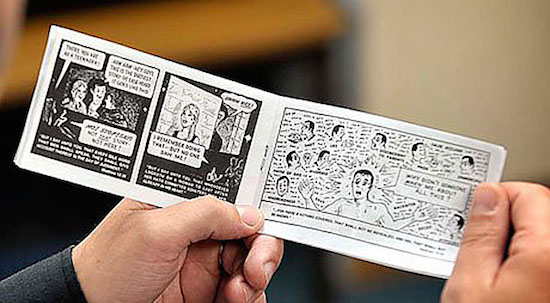
Since his own Damascus moment in 1948 (while listening to “Charles Fuller’s Old Fashioned Revival Hour” on the radio), Chick claims to have won hundreds of thousands of souls for Christ worldwide through the dissemination of his mini-comics, known as “Chick Tracts.” His distinctly modern, technologically mediated conversion — alone, outside of church, through radio and now the internet — is significant, illustrating his contempt for organized religions and his choice of alternative media to flog the Gospel. More significant, however, is Chick’s proud admission that he appropriated the concept of spreading the Gospel through comics from Mao Tse Tung’s use of propaganda comics in Communist China. While placing Chick in an ideological double bind (he maintains that Communism was a creation of the super-evil Vatican), this revelation is remarkably resonant, considering Chick’s zealous ideological imperative and his savvy propaganda tactics.
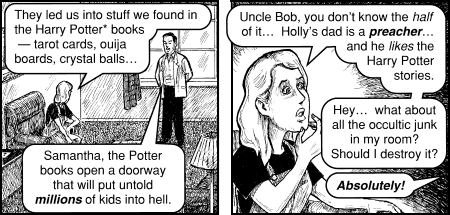
Chick’s themes and strategies vary little from tract to tract, but, as a master propagandist, he tailors many of the tracts for soul-winning target markets, particularly intransigent meanies like bikers, criminals, and rockers. Consider these blurbs from the Chick Publications catalog, advertising specific tracts: “Duke thought Jesus was a sissy. But he learned that Jesus had more guts than anyone who ever lived. Great for truckers and bikers!” (“The Sissy”); “Bob was mean and rotten. He didn’t need God, until a fire in the jail nearly killed him. Great for bikers!” (“Bad Bob”); “They started as a ‘Christian’ rock group, and soon became slaves to rock. But Tom found that Jesus could change all that… and set him free!” (“Angels?”).
Chick writes the majority of the tracts himself, and he draws the most visually amusing of them in his primitive, sub-Peanuts style. The bulk of the tracts, however, feature competent, anatomically correct (if boring) ghost artists. Chick designs the tracts to instill fear and guilt in the unsaved reader. To this end, he menaces us with detailed descriptions of hell, Satan himself (or a few silly, Stooge-like demons), and outrageous, “deviant” behavior. Witchcraft is magically revealed behind hopelessly banal activities in an effort to win casual paranoiacs to the fold. Chick also far outrushes Limbaugh in his violation of PC tolerance — homosexuals (“Doom Town: The Story of Sodom”), women (demons use a pretty women as “tactic #28” to distract a teenage boy from being “saved” in “A Demon’s Nightmare”), civil rights activists, liberals, and other races (and their religions) all get pilloried as tools of Satan.
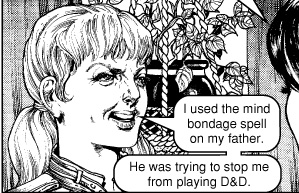
Witchcraft and the occult are always at work in Chick’s suburban universe, often behind seemingly harmless teen activities. The alarmist “Dark Dungeons” exposes Dungeons & Dragons as an occult apprenticeship to witchcraft and Satanism. Innocent Debbie shows such promise in D&D as “Elfstar” that her Dungeonmaster, an older woman, initiates her into a witch’s coven. When a former D&D partner hangs herself because her own character dies, Debbie comes to her senses and is “saved” by a friend. That night, she attends a prayer meeting where a reformed warlock commands the audience to “gather up all your occult paraphernalia… rock music, occult books, charms, Dungeons & Dragons material… don’t throw them away, BURN THEM!”

In “The Poor Little Witch,” Mandy, an uncoordinated, unpopular girl is seduced by her teacher, Mrs. White (Chick is not known for his subtlety) into asking a demon named “Bruth” for special powers. Bruth answers her call, and Mandy is overjoyed with her newfound grace. Later, however, when taken to a ritual infant sacrifice by Mrs. White, she balks, and wants out of Satanism. Unfortunately for Mandy, the whole town is crawling with Satanists: the pastor, the chief of police, her teachers — all witches. As in many tracts involving witchcraft, Mandy’s Leave It to Beaver community is a vertiginous Parallax View of Satanic conspiracy. A sympathetic ex-witch “saves” Mandy, just in time to be murdered for her betrayal. It’s a classic Chick “happy ending,” for, although Mandy’s DOA, she’s on a highway to heaven.
High school is not the only haven for witchcraft in Chick’s world. Established religious organizations are also revealed as dens of the occult. In “The Curse of Baphomet,” Chick exposes Freemasonry as a Satanic cult worshiping Baphomet, a demon goat god of Babylon. Masonic iconography is broken down: the Eastern Star is the upside-down Satanic pentagram; the “all seeing eye” (on our dollar bill) is the eye of Osiris (the Egyptian sun god, based on the Babylonian Baal); the obelisk (the Washington monument) is a phallic symbol of Baal worship (“and God hates it”); the Sphinx is from Egypt, a nefarious Satanic hotbed; the red fez is a shrine to Allah, representing the blood of Christians butchered by Muslims, who dipped their caps in their victims’ blood; the apron worn by high level Masons is “packed with occult symbols,” and its promised righteousness at the Great Throne of Judgment is a cruel lie (“righteousness comes from Jesus Christ, never from an apron”).
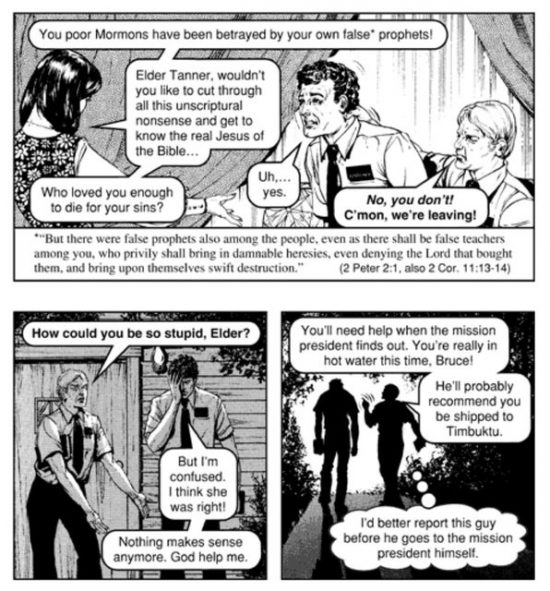
Mormonism is similarly raked over the coals in “The Visitors,” in which two Mormon door-to-door elders try to convert a Christian lady but are shot down by her righteous Chickie niece. After blasting the hapless visitors on such heinous, ungodly practices as polygamy, blood atonement, and belief in false prophecy, plucky Janice accuses Mormon founder Joseph Smith of occult practices such as crystal ball gazing; carrying a talisman of Jupiter (another name for Baal, of course); being a “sublime degree” Mason; incorporating Satanic rituals into Temple ritual (secret handshakes, blood oaths, secret names, etc.); and claiming that Satan and Jesus were brothers. Needless to say, the visitors leave in a huff, and Janice’s aunt is saved.

Any kook evangelical worth his pillar of salt is obliged to riff on rock ‘n’ roll as “the devil’s music.” Chick far outstrips the competition in his rock genealogy, however, proving that Spinal Tap weren’t merely being silly when they performed “Stonehenge” in Druidic chic. Though the Tap maintained that “nobody knew who they were, or… what they were doing,” Chick has done his research. It’s true. Modern rock was spawned by the Druids. In “Spellbound” (one of The Crusaders series of full-sized color Chick comics), Penny, a teenage rock fan, reluctantly gets saved by a visiting preacher, who is coincidentally a former Druid high priest, as well as being a former member of the dreaded Illuminati. According to Lance, our hero, the Druids were “the most evil people living in the horrible darkness” of pre-Christian Europe. They were “so filled with demons that some had strange frightening powers.” (One can only assume that the others just wore silly robes and mumbled arcane phrases.) After describing their penchant for human sacrifice (on which Halloween is based; I’ll get to that), Lance goes straight for the jugular — the Satanic Druid “beat” that accompanied all their ritual sacrifices.
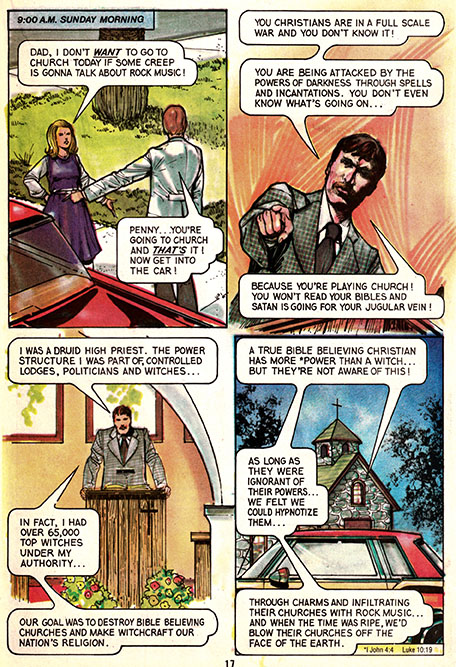
The Druids apparently jammed on flutes, tambourines, and drums covered with human hide. (It’s a shame that Chick seems unaware of Jethro Tull, who make his argument for him rather effectively). “The drumbeat was the key to addict the listener… a form of hypnotism… the same beat the Druids used is in the rock music of today… both hard and soft rock… the beat is still there!” According to Lance, the British Invasion of the ’60s had a hidden agenda beyond chicks and cash. The Beatles “opened up a Pandora’s Box when they hit the U.S. with their Druid/rock beat.” As their popularity grew (due to the hypnotizing, addictive “beat”), “they were able to turn our young people on to the eastern religions… the floodgates to witchcraft were opened… the U.S. will never recover… it was well planned.” Lance knows what he’s talking about. While a Druid, Lance had a “cover job” managing “Z Productions,” one of the “largest manufacturers of rock music.” Apparently, the Frankfurt Schoolers’ conception of the “culture industry” was far too forgiving. Lance reveals how rock music is really made…
“Witches have their own language, like truck drivers use on CB radios. Only the occult language is more carefully guarded. When we produced a rock song, it contained coded spells or incantations that the listener wasn’t aware of. A witch would write the words and we’d dig up an old Druid manuscript containing the melody for the song. Top flight musicians were hired to record the music. The master tape would be set aside for six months. It wasn’t ready for production until it had been blessed. On a full moon some of the most powerful witches in the country would arrive to put the finishing touches on the song. The high priestess summons Regé, Satan’s top demon over the occult.”
When Regé materialized from the center of the pentagram, Lance recalls, the high priestess said, “We bid thee to bless and fulfill the spells of our brothers’ and sisters’ music.” To which Regé replied, “I shall command my servants (the demons) to follow each relic produced from our magic music.” Poof! A top-ten single is born. Lance concludes: “every recording that has been cursed has a visitor (a demon) with it… that’s why your homes are so messed up… you cast the spell on yourself!” As the sermon builds to a frothing pitch, Lance commands the congregation to burn it all. Country music (“about sleeping with other men’s wives”), and corset-busting romance novels (“those ungodly love stories… the bestsellers with the filthy language”) get torched too. Moved by Lance’s fervid testifying, Penny repents, agrees to burn her rock albums, and is saved.

But what about “Christian rock”? It’s a demon in disguise as well, as shown in “Angels?,” perhaps the most hilarious tract in all God’s creation. In this clumsy, Chick-drawn tract, a hard luck Christian group meets a “manager” while on the chapel circuit named Lew Siffer (!!!), who promises them booze, chicks, and limos if they sign on the dotted line… in blood! After the boys sign with Lewie, he outlines the structure of his musical conglomerate — a worldwide organization known as “Killer Rock.” Pointing to a hierarchical flow chart, he traces the evolution of rock, from Soft (1950s–60s), through Hard (1961–71), to Heavy (1971–?), claiming responsibility for it all. “From the ’70s on, I gave the world Kiss, Black Sabbath, Mötley Crüe, etc.”
Predictably, the Green Angels rocket to mega-stardom overnight with their mesmerizing songs (“We’re gonna rock, rock, rock/Rock with the ROCK!”), only to topple, one by one, to AIDS, drugs, and [gasp]… vampirism. Luckily, a devoted Chickie plants a tract (“The Contract”) in guitarist Tom’s pocket before their final gig. He reads it later, and is saved. Mr. Siffer tries to collect his “royalties,” but Tom, using the Force (“The Lord rebuke thee Satan! Get thee hence!!!”) zaps (literally) the debonair Lew, revealing his dorky demonic self, horns and all, in an embarrassing shade of red.
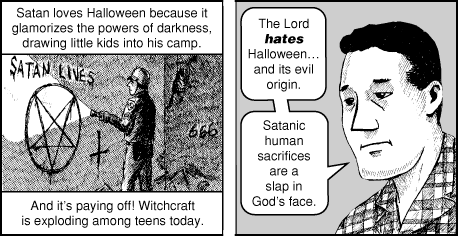
We owe more than the existence of Mötorhead to those seminal Druids — we have them to thank for Halloween as well. Two tracts, “Boo!” and “The Trick” (“great for kids!”), trace trick-or-treating to the Druids (“those guys were really spooky!”). Apparently, October 31st was a special holiday for Samhain (Satan, the god of the dead). Druids sacrificed humans as a matter of protocol, but Halloween was a sacrificial block party. They would go from house to house, demanding a child for sacrifice from each — the victim was the Druids’ “treat.” They would then leave a lit Jack-O-Lantern outside the house to protect the rest of the family from demons for the rest of the night. If the household could not provide a sacrificial rugrat, or refused, the nasty Druids painted a Satanic pentagram on their front door. Later that night, in a cruel reversal of Passover, Samhain or one of his demons would come and kill a member of the family, usually from fright. This was the “trick.” Of course, Druids and witches are still active today, explaining the old “razor blade in the apple” phenomenon. This is not the work of demented old ladies, says Chick, but of witches performing covert ritual sacrifices to Satan. Satan also uses the scary costume tradition of Halloween to lure kids into his club every year, accounting for the fact that “witchcraft is exploding among teens today!”
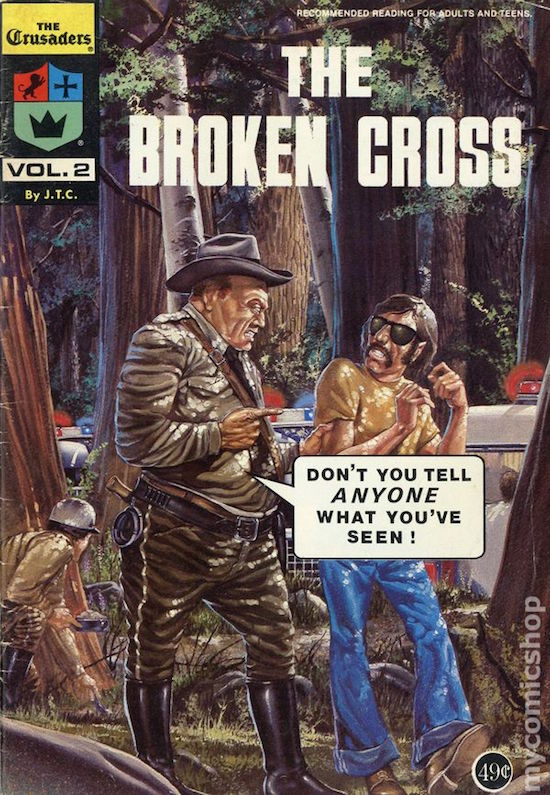
As needlessly alarmist as Chick Tracts are, they are strictly Mickey Mouse in comparison to The Crusaders series of full-sized color comics. Chick authored The Crusaders series from the mid-’70s to the early ’80s, and it shows. The two Crusaders themselves constitute a fundamentalist Christian Mod Squad — two muscular young men, one black, one white, both square-jaw handsome — who travel the world in polyester leisure suits helping good Christians and “saving” those who have run astray. Tim Clark, the Steve Canyon white guy, is a former Green Beret, while “Big” Jim Carter, complete with afro and Superfly duds, is a former drug-dealing badass who was saved by a neighborhood minister. Unlike the primitive tracts, with their goofy, overweight demons and HAW! HAW! panels, The Crusaders comics are bulging with paranoiac text and posable action figure artwork. The plotlines are incidental, as The Crusaders series is primarily a vehicle for Chick’s deeply paranoid and hate-mongering conspiracy theories about the Roman Catholic church. In each “adventure,” the two heroes either run into or accompany a pedagogical character who functions as a mouthpiece for Chick’s spiraling conspiracies.

In the final six volumes of The Crusaders, Chick allows a real live former Jesuit, Dr. Alberto Rivera, to take the stand and expose the spidery depths of the Satanic Vatican world conspiracy. In these issues, the two Crusaders are merely in the room as Alberto outlines the Vatican’s devilish plot to bring about the One World Religion and Government which will herald beginning of the Great Tribulation. Alberto spins an all-encompassing, impossibly web-like conspiracy theory, an unfortunate conflation of Pynchon and Hitler. Under the guidance of Satan, according to Alberto, the Roman Catholic church is responsible for nearly every evil event in world history. The Alberto series renders more classic conspiracy theories positively comforting. Even the dreaded Illuminati, usually the shadowy umbrella organization behind all conspiracies, is merely a side project of the Jesuit order and subordinate to the Vatican. In his conception of the Roman Catholic church as a hotbed of fiendish decadence and moral rot, Chick ultimately reveals himself to be something of a Puritan, making his peculiar brand of evangelism not only staunchly Protestant, but distinctly American as well. He is the Charles Schulz of Calvinism.
[Editor’s note: Jack Chick died in 2016 at the age of 92. It is not known if he is in heaven or the HAW! HAW! place.]
Originally published in 21C magazine, issue #8, 1996.
CURATED SERIES at HILOBROW: UNBORED CANON by Josh Glenn | CARPE PHALLUM by Patrick Cates | MS. K by Heather Kasunick | HERE BE MONSTERS by Mister Reusch | DOWNTOWNE by Bradley Peterson | #FX by Michael Lewy | PINNED PANELS by Zack Smith | TANK UP by Tony Leone | OUTBOUND TO MONTEVIDEO by Mimi Lipson | TAKING LIBERTIES by Douglas Wolk | STERANKOISMS by Douglas Wolk | MARVEL vs. MUSEUM by Douglas Wolk | NEVER BEGIN TO SING by Damon Krukowski | WTC WTF by Douglas Wolk | COOLING OFF THE COMMOTION by Chenjerai Kumanyika | THAT’S GREAT MARVEL by Douglas Wolk | LAWS OF THE UNIVERSE by Chris Spurgeon | IMAGINARY FRIENDS by Alexandra Molotkow | UNFLOWN by Jacob Covey | ADEQUATED by Franklin Bruno | QUALITY JOE by Joe Alterio | CHICKEN LIT by Lisa Jane Persky | PINAKOTHEK by Luc Sante | ALL MY STARS by Joanne McNeil | BIGFOOT ISLAND by Michael Lewy | NOT OF THIS EARTH by Michael Lewy | ANIMAL MAGNETISM by Colin Dickey | KEEPERS by Steph Burt | AMERICA OBSCURA by Andrew Hultkrans | HEATHCLIFF, FOR WHY? by Brandi Brown | DAILY DRUMPF by Rick Pinchera | BEDROOM AIRPORT by “Parson Edwards” | INTO THE VOID by Charlie Jane Anders | WE REABSORB & ENLIVEN by Matthew Battles | BRAINIAC by Joshua Glenn | COMICALLY VINTAGE by Comically Vintage | BLDGBLOG by Geoff Manaugh | WINDS OF MAGIC by James Parker | MUSEUM OF FEMORIBILIA by Lynn Peril | ROBOTS + MONSTERS by Joe Alterio | MONSTOBER by Rick Pinchera | POP WITH A SHOTGUN by Devin McKinney | FEEDBACK by Joshua Glenn | 4CP FTW by John Hilgart | ANNOTATED GIF by Kerry Callen | FANCHILD by Adam McGovern | BOOKFUTURISM by James Bridle | NOMADBROW by Erik Davis | SCREEN TIME by Jacob Mikanowski | FALSE MACHINE by Patrick Stuart | 12 DAYS OF SIGNIFICANCE | 12 MORE DAYS OF SIGNIFICANCE | 12 DAYS OF SIGNIFICANCE (AGAIN) | ANOTHER 12 DAYS OF SIGNIFICANCE | UNBORED MANIFESTO by Joshua Glenn and Elizabeth Foy Larsen | H IS FOR HOBO by Joshua Glenn | 4CP FRIDAY by guest curators
